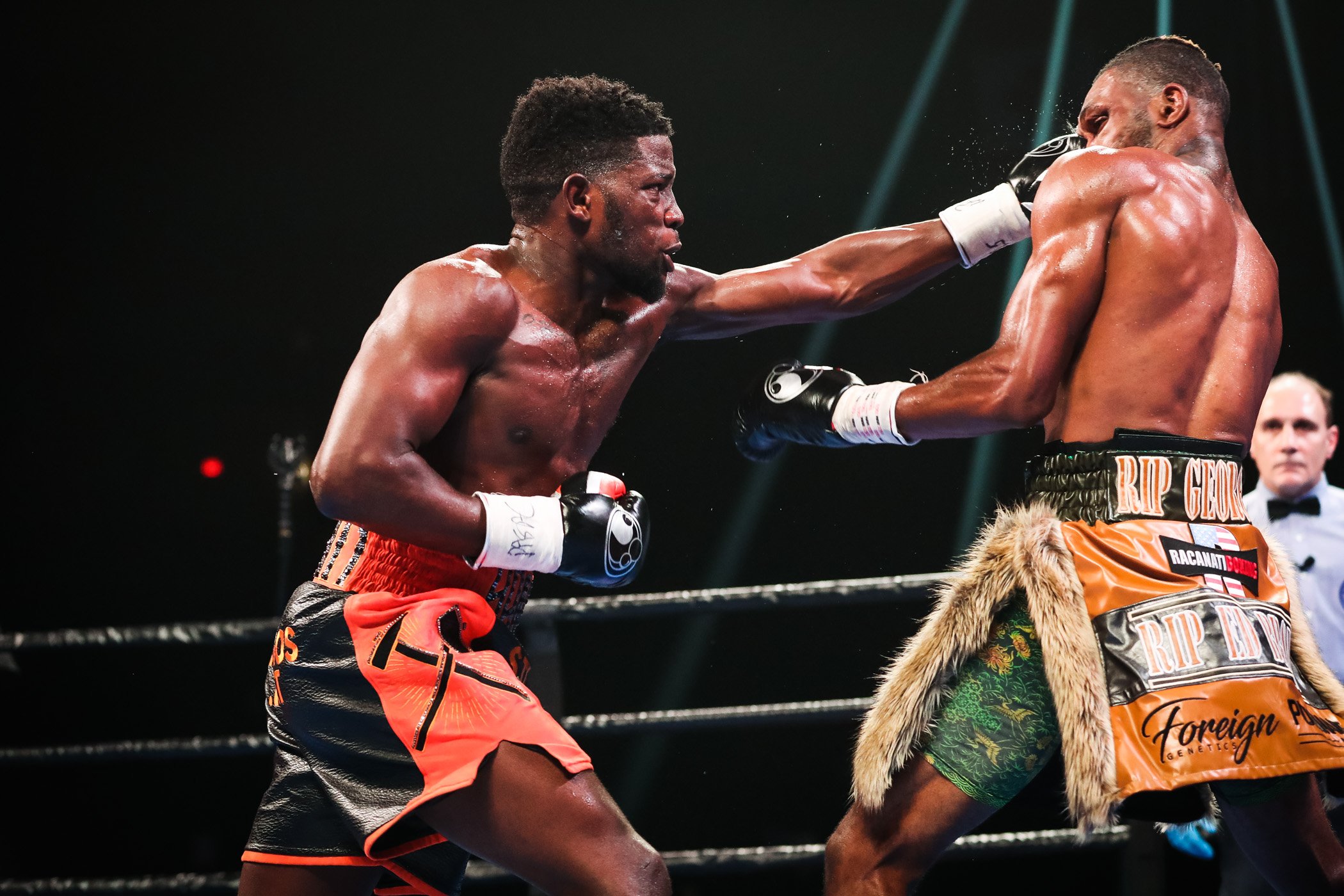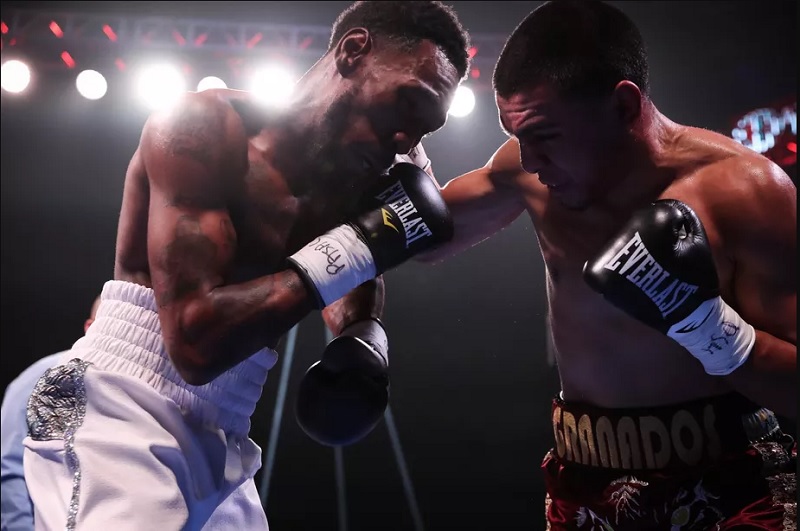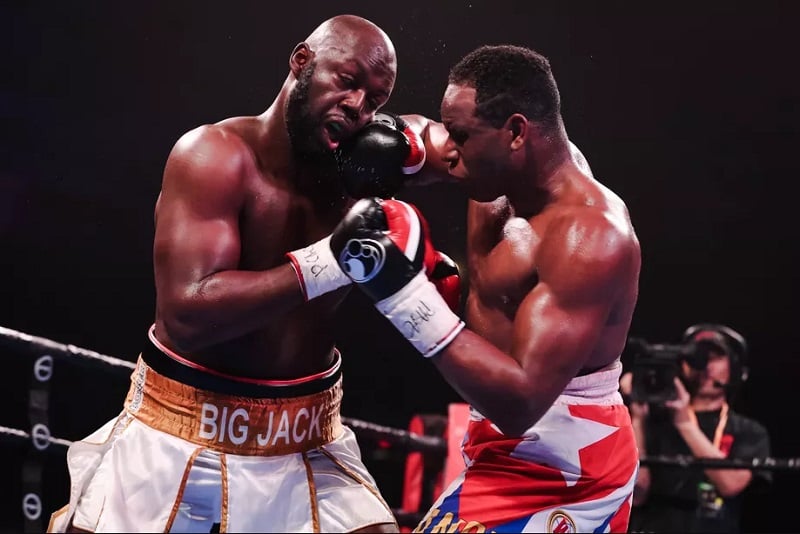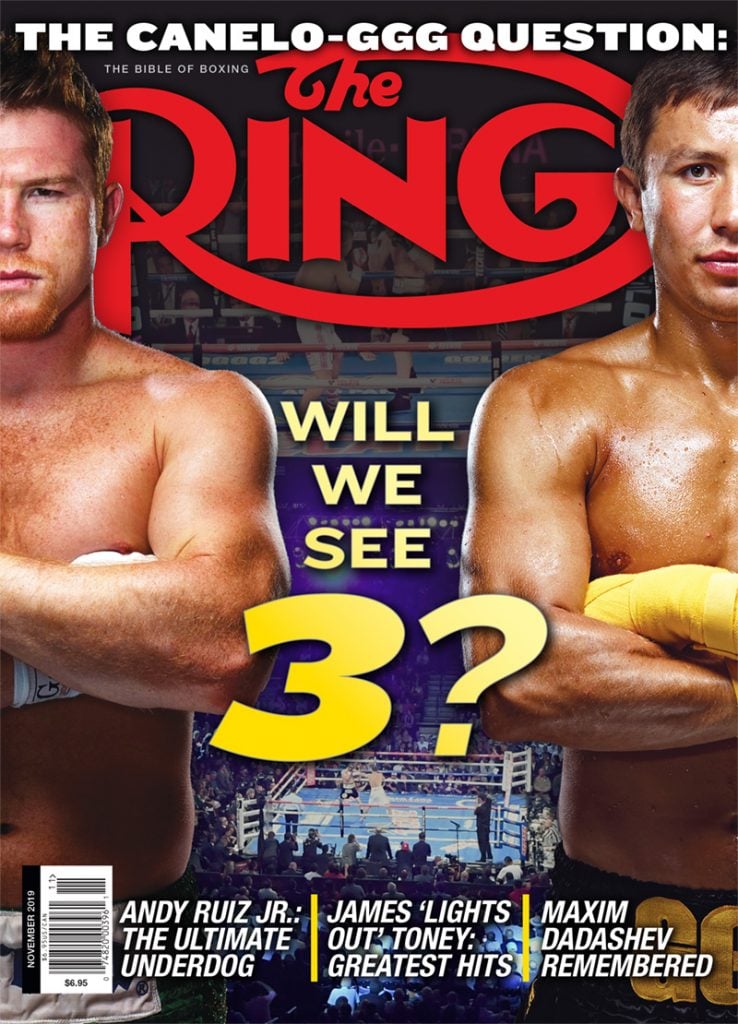The Travelin’ Man goes to Reading, Pennsylvania: Part Two

Please click here to read Part One.
Saturday, October 26 (continued): When Erickson Lubin was driving toward his eventual title shot against then-WBC junior middleweight beltholder Jermell Charlo in October 2017, the most defining characteristic of his game – besides his southpaw stance – was his punching power. Entering the Charlo match, the undefeated Lubin had 13 knockouts among his 18 wins, all of which were completed inside four rounds, and he invested so much of his ring identity into his power that the fighter nicknamed “The Hammer” named his right hand “Sledge” and his left fist “Jack.”
Some experts – including myself – thought Lubin had the talent to defeat Charlo but the defending titlist proved he also had one-punch KO capacity by doing just that to Lubin. A perfectly placed and sublimely timed uppercut caught Lubin as he was ducking and the result was a knockout just 161 seconds after the opening bell.
Following such a devastating and disappointing loss, a fighter must confront his failure and decide how to move forward. Some never return to their previous heights while others overcome the mental trauma and become champions. As aptly pointed out by Showtime’s Mauro Ranallo, today’s crop of 154-pound titleholders is proof that a loss should not be considered a death sentence. The proof: Two of the three widely recognized champions – IBF/WBA titlist Julian Williams and WBC counterpart Tony Harrison – overcame KO defeats before reaching their personal mountaintops. For Williams, Jermell’s twin Jermall (then the IBF junior middleweight titlist) inflicted the blemish as he stopped “J Rock” in round five in December 2016. For Harrison, he overcame two stoppage defeats (to Willie Nelson in July 2015 and to Jarrett Hurd in February 2017) to dethrone WBC titlist Jermell.
It remains to be seen how the rest of Lubin’s career will play out but if his comprehensive 10-round decision win over Nathaniel Gallimore is any indication, “The Hammer” will get another chance to nail down a championship opportunity – and when he does, he’ll have more than just “Jack” and “Sledge” at his disposal. Knowing a full-frontal assault would be foolish against the aggressive and hard-hitting Gallimore, Lubin executed the game plan assembled by trainer Kevin Cunningham – work behind his jab, change his levels, be willing to retreat in order to create his optimal punching range, exercise patience and gun for the KO, should the Jamaican show any signs of weakness. From this vantage point, a balanced offense was a key component to the blueprint and the numbers bore that out.
Of Lubin’s 471 total punches, 256 were jabs and 215 were power shots – a punch distribution of 54-46 in favor of jabs that was a direct reversal of the 54-46 split in favor of power shots recorded in his five previous CompuBox-tracked fights against Juan Cabrera, Jorge Cota, Jermell Charlo, Ishe Smith and Zakaria Attou. However not only did Lubin throw the jab, he was effective with it as he out-jabbed his taller and longer-armed opponent 46-14 and led 18%-6% in accuracy. In fact, Lubin landed more jabs to the body (21) than Gallmore’s jab landed to all targets (14, including six to the body) and that diversity of location surely helped Lubin set up the rest of his offense.
Speaking of body punching, Lubin landed 57 body shots that accounted for 41.7% of his total connects, well above the 29.5% CompuBox average. Gallimore also produced a devoted body attack as his 38 connects accounted for 57.5% of his total but he fell short because he was out-landed 137-66 in terms of total connects and 91-52 in landed power punches. Lubin also was the more accurate hitter (29%-16% overall, 18%-6% jabs, 42%-29% power) and Lubin led 10-0 in the CompuBox round-by-round breakdown of total connects, which mirrored the official scores of 99-91 on all three cards.

Erickson Lubin (left) vs. Nathaniel Gallimore. Photo credit: Amanda Westcott/Showtime
Lubin gave full credit to Cunningham, whose work with southpaw champions Cory Spinks, Devon Alexander and David Diaz made him eminently qualified to reshape and expand Lubin’s toolbox.
“I had a tremendous training camp thanks to Kevin Cunningham,” Lubin said in Joe Santoliquito’s fight report on RingTV.com. “Kevin is a real strict trainer and he’s a southpaw specialist. We just improving our game every camp. We drew the game plan up in camp and we executed. I knew [Gallimore] was tough and his game plan was to rough me up. I wasn’t going to fall into his game plan. I have good power and I used my boxing ability. That really helped me.”
To Gallimore’s credit, he offered no excuses and gave Lubin his proper due.
“Lubin was slick and I just couldn’t get my punches off,” Gallimore admitted in the fight report. “He was the better man tonight but I will be back and better. I was never hurt during the fight. We bumped legs a couple times and he was able to land a couple shots while I was off-balance. It’s always difficult to fight a southpaw.
“I could have done more but I kept fighting to the end just like I always will,” he concluded. “It just wasn’t my night.”
*
Coming off his devastating seventh round KO loss to Danny Garcia, it would have easy to believe that Adrian Granados was nearing the end of an honorable career – a career that has been defined by wrenching judicial disappointments. Of his seven career losses on points, five were by either split (Jose Juan Fuentes in his second pro fight, Brad Solomon and Adrien Broner) or majority decision (Frankie Gomez and Felix Diaz) and he also fought draws with Lanardo Tyner and Kermit Cintron, who, by the way, is a Puerto Rican native based in Reading, Pennsylvania. A case could be made that his efforts in most of those fights deserved a better mathematical fate, so If Shawn Michaels is professional wrestling’s “Heartbreak Kid,” then Adrian Granados may well be boxing’s. For his willingness to return to the ring time and again – and give everything of himself only to officially fall short – he must be considered one of boxing’s most emotionally resilient participants.
Both Granados and Robert Easter Jr. – who was coming off back-to-back blemishes against Mikey Garcia (a lopsided L UD 12) and Rances Barthelemy (a less-than-scintillating draw) – had plenty to prove when they entered the ring. While Granados wanted to show he was better than the fighter who was so easily dispatched by Garcia, Easter wanted to re-establish himself as an exciting fighter to watch. Once upon a time, Easter produced more than his share of eye-catching offensive displays and his one-punch, fifth round KO over Argenis Mendez on April Fool’s Night 2016 was as spectacular as a fighter could ever want. There have been no such explosions from Easter since then – each of his last six fights went the distance – and in only one of those bouts, an IBF lightweight title defense against Luis Cruz, did he display his previous fusion of power and dominance. Stung by the criticism his April chess match with Barthelemy received, Easter dearly wanted to erase the stench he and Barthelemy left with most fans by resurrecting his most exciting self.
The pre-fight confluence of circumstances combined with the mesh of styles ended up producing one of 2019’s most pulse-pounding slugfests. Granados’ all-heart, ever-charging attack enabled him to dart inside Easter’s long arms with regularity while those charges also provided Easter with the perfect canvas to fire crisp combinations. In a fiercely fought round one, both men each landed 21 total punches, with Easter needing 67 punches to reach that mark to Granados’ 77.
From there, Granados got exactly the type of fight he wanted: A high-octane, grueling punch-out in which conditioning, mental fortitude and toughness were paramount. This pitched battle saw the pair throw a combined 1,815 punches that included 1,379 power punch attempts and the raw numbers indicated an easy win for Granados as he threw more (99.4 punches per round to Easter’s 82.1), landed more often in all categories (391-239 overall, 68-31 jabs and 323-208 power) and connected with more frequency in all phases (39%-29% overall, 33%-13% jabs, 41%-35% power). Besides clean punching, effectiveness and defense, Granados, by forcing the trench war that better suited his style, also was the superior ring general. The CompuBox round-by-round breakdown had Granados ahead 9-0-1, meaning that he swept the raw numbers in each of the final nine rounds following the even round one.
Yet when the judges’ scorecards were rendered, they were lopsidedly in favor of Easter – 97-93 by Kevin Morgan, 98-92 by Julie Lederman and 100-90 by John Poturaj. Surprisingly the final result engendered no outcry from the Showtime broadcasters, ringside scorer Steve Farhood (who scored Easter a 97-93 winner), the crowd inside the arena or from those who took part in the network’s Twitter poll (of which 66% deemed Easter the victor).
Why?
It’s a good question to ask, especially given that one of the most reliable CompuBox axioms is that the fighter who lands more punches over the course of a fight goes on to win the decision around 95% of the time. Moreover the CompuBox round-by-round breakdown of total punches often comes close to the margins submitted by the judges. However after the decision in Easter’s favor was announced, the only complaint came from Granados.

Robert Easter Jr. (left) vs. Adrian Granados. Photo credit: Amanda Westcott/Showtime
“I’m speechless,” he said in Santoliquito’s fight report. “I felt like I won the fight. That 100 to 90? Come on now. I’m tired of the same old story. It was clear that I controlled the fight. He never had me hurt. That was embarrassing.
“I can’t control the judging. It’s very frustrating. I have a dream to be a world champion and it just seems like it’s not cutting out for me but I have the heart of a champion and I’m not giving up.”
Despite my belief that Granados’ work deserved much better than the scores he received, I can understand how the judges arrived at their winner (if not their margins for their winner). It was one of those fights that legitimately falls into the 5% that CompuBox’s figures alone can’t explain.
Here’s how: Of the four criteria judges use to determine the winner of a given round, clean effective punching carries the most weight. The taller, rangier Easter’s punches were long, snappy, easy-to-see offerings that mostly targeted the head, so much so that Granados’ face reddened after a few rounds. Easter’s blows were pleasing to the eye and landed with enough authority and frequency to create a positive imprint. Conversely the vast majority of Granados’ offerings were short, compact blows that didn’t come close to Easter’s in terms of visibility or power, factors that could have made his punches pale in comparison to Easter’s. In CompuBox’s world, contact to the scoring area – regardless of the force with which it lands – counts as a connect and while Granados’ blows touched Easter many more times, Easter’s connects carried the blend of accuracy and force that is vital to successful scoring in the pro game.
Moreover many of Granados’ punches were to the body – he led 153-49 in landed body shots – and the majority of those connects needed an optimal viewing angle to be granted proper credit.
Thanks to our ringside position that includes a TV monitor and an experienced director in the truck, we CompuBox operators had the angles we needed during those times when our line-of-sight perspective was less than optimal, such as when the referee obscures our view or when the fighters are parallel to us instead of perpendicular. During a fight, my eyes constantly float from the ring to the monitor and back based on what is happening in front of me and I believe this setup allows me and my colleagues to maximize our performances as punch counters. Because the judges don’t have the benefit of monitors, they aren’t able to get a perfect view of each punch from every part of the ring the way we do, which, in turn, may affect how they score the closer rounds and may also explain why one judge scores a certain round for one fighter while another jurist scores the same round for his opponent.
These dynamics, combined with Granados’ hyperactive work rate in comparison to Easter’s and his superior accuracy, are the reasons Granados had such a large advantage in total connects. But because his connects didn’t carry sufficient force in comparison to Easter’s, Easter was given credit by the judges in enough rounds to get the “W.”
With the recent expansion of instant replay – which was used so expertly by Pennsylvania State Athletic Commission Executive Director Greg Sirb last week in nullifying former WBC light heavyweight titlist Oleksandr Gvozdyk’s first round “knockdown” – state commissions should consider expanding the technological revolution by approving the installation of TV monitors at the judges’ work stations whenever networks are on site to broadcast cards. This move will allow three of the most important people in a given fight to have the best possible view of the action that is before them every second of every round and that, in turn, could produce even better consistency and performance.
*
In building a reported 214-6 amateur record, Las Vegas-based Cuban Frank Sanchez successfully adjusted to a long string of blind tournament draws and last-minute changes in opponents, so it shouldn’t have been a surprise that he produced a three-way 100-90 victory over Belgian-based Congolese Jack Mulowayi on very short notice. In his first outing longer than six rounds in his 14-fight pro career, Sanchez gave fans a better and more complete look at his methodical ring temperament, his above-average concentration, his well-honed technique, his offensive variety and his patience against an athletic but survival-minded opponent.
In counting Mulowayi’s only pro loss before tonight, a 10-round majority decision defeat to Herve Hubeaux two fights earlier, I thought he had the look of a boxer – tall, well-built, mobile and quick – but I also believed he was done in by his willingness to remain a half-step farther away from his ideal punching range. Because of this, Mulowayi punched at his target instead of through it, so despite being the much more active fighter (62.9 punches per round to Hubeaux’s 36.6), Hubeaux got the “W” thanks to his sustained aggression, superior accuracy (18%-12% overall, 37%-25% power) and one-shot power (he scored the fight’s only knockdown in round four), assets that Sanchez wanted to emulate.
Not only did Sanchez duplicate most of what Hubeaux did, he added to it by being the more active fighter almost by default as he averaged a modest 45.5 punches per round to Mulowayi’s meager 18.5 and, despite being the slightly shorter fighter with the somewhat lesser reach, he won the battle of the jabs by throwing it and landing it more often (219 to 68 in attempted jabs, 37-11 in connects). Sanchez also was the more committed body puncher (63-12), the more successful power puncher (84-19 in connects, 36%-16% in accuracy) and he logged 10 or more total connects in all but round three (seven) while Mulowayi never landed more than six total punches in any given round, recorded one connect three times and went 0 for 12 in round six. In fact, over 10 rounds, Mulowayi landed just 30 punches while Sanchez recorded 121. No, Sanchez didn’t floor Mulowayi like Hubeaux did but he performed well in every other respect.
While happy to win, Sanchez was disappointed he wasn’t given the chance to show more of his wares.

Frank Sanchez (right) vs. Jack Mulowayi. Photo credit: Amanda Westcott/Showtime
“My opponent didn’t really want to fight,” Sanchez said in Santoliquito’s report. “He just wanted to fight dirty. So all I could do was give him some lateral movement. It’s difficult when someone doesn’t want to engage. We wanted to touch him down, touch him up high, but once he got touched, the guy just tried to tie up. I tried to hit him at the belt to get his guard down but when the opponent doesn’t want to fight, it’s very tough. There was no problem going 10 rounds. I’m in great shape and I’m ready to fight again as soon as possible.
According to Santoliquito’s story, Mulowayi felt he was starting to land more punches after the seventh round and the stats bore him out. In rounds one through six, he landed 13 punches but in rounds seven through 10, his total swelled to 17, including the fight-high six in the seventh. That said, his efforts weren’t nearly enough to dent the scorecards.
“I should have pressed him from the beginning like my team told me to,” he concluded.
Regret can be a powerful motivator but will Mulowayi be given a second chance on U.S. TV to dispose this bitter pill? If so, it won’t be against Sanchez, who will move on to the next rung on the ladder.
*
Needing to assemble the night’s data and to send it to the Draft Kings people, I decided to skip the crew meal and drive directly back to the crew hotel. Upon my arrival, I bought a bottle of Coke Zero from the lobby’s gift shop and munched on the bag of peanuts I purchased earlier in the day. After finishing my work, which, given the 30 rounds I needed to record, required about 45 minutes, I consumed my post-card bounty and turned out the lights shortly after 3 a.m.
Sunday, October 27: The next five hours were very restful and when my eyes opened, I was ready to get another travel day started. Following the morning routines, I cranked out words on the laptop with an eye on the clock: Shut down the computer at 10, leave the hotel by 10:15 and hope I get to Philadelphia International Airport by noon to catch my 1:52 flight to Pittsburgh.
The wisdom of my timeline was confirmed the moment I pulled back the curtain and realized that it not only was raining but had been doing so for hours. Wet roads, at least for me, necessitate slower and more careful driving and leaving at 10:15 would give me the time cushion I need to arrive in Philadelphia with time to spare.
This I did and after turning in my rental car and clearing security, I ate a leisurely brunch at a restaurant directly across the way from my gate, then spent the final 50 minutes before boarding producing another 1,000 words on the laptop to extend today’s total to more than 2,000. By the time I boarded the aircraft, I felt good enough about my situation to settle into my 11th row aisle seat and relax before the final drive home.
The pilot warned us that our 46-minute flight would be very choppy due to high winds but it turned out to be anything but. The wheels touched down in Pittsburgh at 2:58 p.m.; I was inside my car by 3:30 and arrived home shortly before 6. As is more often the case these days, travel days – especially homebound ones take a toll on me. I want nothing more than to take it easy but with tons of work awaiting me and only three full days to finish it before my next journey, I spent the next few hours working on my “to do” list so I would be in a better position entering tomorrow morning.
Speaking of my next journey, I am scheduled to leave Thursday for a “ShoBox: The New Generation” quadrupleheader topped by a scheduled 10-rounder between junior lightweights Xavier Martinez and Jessie Cris Rosales and supported by junior welterweights Richardson Hitchins and Kevin Johnson, middleweights Kevin Newman II and Mark Anthony Hernandez and lightweights Rolando Romero and Juan Carlos Cordones. The venue – Sam’s Town Hotel and Gambling Hall in Las Vegas – made a very positive impression on me during my initial visit in April, so I am very much looking forward to staying there for the second time.
Until then, happy trails!
*
Lee Groves is a boxing writer and historian based in Friendly, West Virginia. He is a full member of the BWAA, from which he has won 16 writing awards, including two first-place awards, since 2011. He has been an elector for the International Boxing Hall of Fame since 2001 and is also a writer, researcher and punch-counter for CompuBox, Inc. He is the author of “Tales from the Vault: A Celebration of 100 Boxing Closet Classics” (available on Amazon) and the co-author of “Muhammad Ali: By the Numbers” (also available on Amazon). To contact Groves about a personalized autographed copy, use the email [email protected] or send him a message via Facebook.
Struggling to locate a copy of The Ring Magazine? Try here or
Subscribe
You can order the current issue, which is on newsstands, or back issues from our subscribe page.















